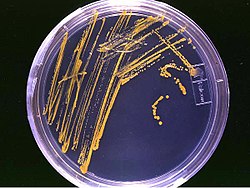A growth medium or culture medium is a liquid or gel designed to support the growth of microorganisms or cells, or small plants like the moss Physcomitrella patens. There are different types of media for growing different types of cells.
 |
| An agar plate |
There are two major types of growth media: those used for cell culture, which use specific cell types derived from plants or animals, and microbiological culture, which are used for growing microorganisms, such as bacteria or yeast. The most common growth media for microorganisms are nutrient broths and agar plates; specialized media are sometimes required for microorganism and cell culture growth. Some organisms, termed fastidious organisms, require specialized environments due to complex nutritional requirements. Viruses, for example, are obligate intracellular parasites and require a growth medium containing living cells.
- To prepare sterile nutrient agar for culturing microorganisms.
A widely-used method for heat sterilization is the autoclave,
sometimes called a converter. Autoclaves commonly use steam heated to
121–134 °C (250–273 °F). To achieve sterility, a holding time of at
least 15 minutes at 121 °C (250 °F) or 3 minutes at 134 °C (273 °F)
is required. Additional sterilizing time is usually required for
liquids and instruments packed in layers of cloth, as they may take
longer to reach the required temperature (unnecessary in machines that
grind the contents prior to sterilization). Following sterilization,
liquids in a pressurized autoclave must be cooled slowly to avoid
boiling over when the pressure is released. Modern converters operate
around this problem by gradually depressing the sterilization chamber
and allowing liquids to evaporate under a negative pressure, while
cooling the contents. Proper autoclave treatment will inactivate all fungi, bacteria, viruses and also bacterial spores, which can be quite resistant. It will not necessarily eliminate all prions.
Autoclaves are widely used in microbiology, medicine, tattooing, body piercing, veterinary science, mycology, dentistry, chiropody and prosthetics fabrication. They vary in size and function depending on the media to be sterilized.
Typical loads include laboratory glassware, surgical instruments, medical waste, patient pair utensils, animal cage bedding, and lysogeny broth.
A notable growing application of autoclaves is the pre-disposal
treatment and sterilization of waste material, such as pathogenic
hospital waste. Machines in this category largely operate under the same
principles as conventional autoclaves in that they are able to
neutralize potentially infectious agents by utilizing pressurized steam
and superheated water. A new generation of waste converters is capable
of achieving the same effect without a pressure vessel to sterilize
culture media, rubber material, gowns, dressing, gloves, etc. It is
particularly useful for materials which cannot withstand the higher
temperature of a hot air oven. For all-glass syringes, sterilizing in a
hot air oven is a better method.
Autoclaves are also widely used to cure composites and in the
vulcanization of rubber. The high heat and pressure that autoclaves
allow help to ensure that the best possible physical properties are
repeatably attainable. The aerospace industry and sparmakers (for
sailboats in particular) have autoclaves well over 50 feet long, some
over 10 feet wide.
Conclusion:
This report was identified the correct way to
prepare a culture media. The type of culture media was used nutrient agar which prepare suitable medium for microorganisms
growth. To culture the microorganisms in the nutrient agar, few
steps of sterilization was taken to avoid any contamination on the
colony. Autoclaving is the
process used to sterilize the nutrient agar. The media was inserted into
an autoclave which is a large pressure cooker. The chamber provided
high temperature and pressurized steam
References:







No comments:
Post a Comment